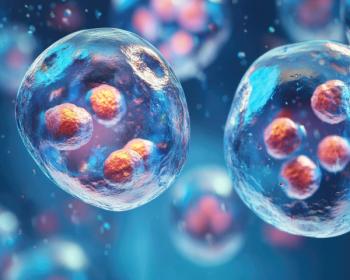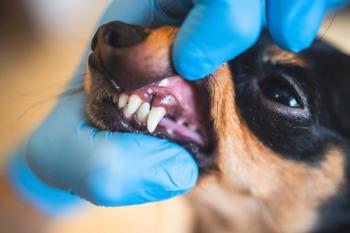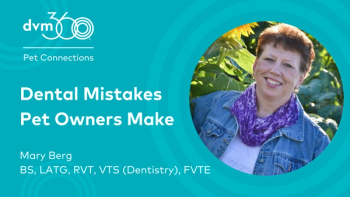
How to close intraoral wounds and incisions
Check out these best practices for choosing dental sutures, needles and suturing methods.
You're staring at a 5-mm hole left after extracting a dog's lower second premolar. Which suture, needle and knot do you choose? A similar packet to what you used on that ovariohysterectomy you performed earlier in the day? Actually, that would be a poor choice.
The objective of dental suturing is to close surgical defects and promote first intention healing without traction of the soft tissue. You'll want suture material that has little tissue reaction and is easy to handle, strong enough to hold the tissues together and attached to a strong needle that stays sharp and stable in the needle holder. When used properly, surgical sutures should hold the gingiva or flap edges in apposition until the wound has healed enough to withstand normal functional stresses, thus improving patient comfort.
Suture materials
Suture material is classified as natural or synthetic; absorbable or nonabsorbable; monofilament or multifilament. A suture should:
- Have tensile strength appropriate for its respective use
- Have tissue biocompatibility
- Be easy to handle
- Allow minimal knot slippage
- Absorb with minimal reaction after the tissue has healed
It's important to select the specific suture thread and diameter based on the thickness and general health of the tissues to be sutured.
For intraoral surgery, absorbable suture that will lose its tensile strength at about the same rate the tissue gains strength is generally chosen. Normally, wound healing takes place in 14 to 21 days, with variation based on blood supply, patient age, nutritional status, presence of infection or systemic disease and corticosteroid use. Suture options include:
• Plain catgut suture, which absorbs by the action of intraoral enzymes (Photo 1). Catgut loses most of its tensile strength in 24 to 48 hours and is resorbed in the oral cavity within one week. Because of this rapid loss of tensile strength, especially in infected areas, surgical gut should be avoided for intraoral surgery. Chromic-coated catgut increases absorption up to 10 days and tensile strength up to five days.
Photo 1: 5-0 surgical plain gut suture on a ½ circle reverse cutting needle.
• Synthetic, absorbable suture materials, which deliver minimal tissue reaction, loss of tensile strength and increased absorption times that provide adequate time for oral incisions to heal. They're hydrophobic—primarily broken down through the process of hydrolysis with only a mild tissue reaction. Exposure to oral infections and digestive enzymes doesn't markedly affect the absorption rate.
• Polyglycolic acid (PGA—Dexon), an absorbable, synthetic, multifilament suture material that retains strength intraorally for 21 to 28 days and remains in the mouth for months (Photo 2). But I think that's too long. PGA possesses 1.4 times the wet knot strength of chromic gut and two times the strength of plain gut.
Photo 2: 4-0 PGA suture on a â -in. reverse cutting needle.
• Vicryl Rapide (Ethicon/Novartis Animal Health), a braided, undyed, synthetic and absorbable polyglactin-910 suture that retains tensile strength for 10 to 14 days and is absorbed completely by phagocytosis in 35 days (Photo 3). I think this is an ideal suture for fast-healing wounds in the oral cavity where the suture actually falls off the wound by day 12. Additionally, this suture is soft, so it shouldn't irritate the animal as some monofilament sutures can.
Photo 3: 4-0 Vicryl Rapide suture on a â -in. cutting needle.
• Monocryl (Ethicon/Novartis Animal Health), a monofilament, synthetic and absorbable poliglecaprone-25 suture noted for ease of handling, as well as knot security and strength (Photo 4). It retains 21 days of tensile strength and absorbs in 78 days. Monofilament suture materials are stiffer, making handling more difficult, and they may increase oral irritation.
Photo 4: 2-0 Monocryl Plus (active) suture on a â -in. reverse cutting needle.
• Coated Vicryl Rapide (Ethicon/Novartis Animal Health), a braided, synthetic and absorbable polyglactin-910 coated suture that retains tensile strength for 28 days and absorbs in 68 days (Photo 5).
Photo 5: Two different needle choices for Vicryl Rapide suture.
• PDS II (Ethicon/Novartis Animal Health), a monofilament, synthetic and absorbable polydioxanone suture that retains tensile strength for 56 days and absorbs in 180 days. Unfortunately, its slow absorption may cause wound complications (e.g., inflammation, infection, granuloma).
•Antibacterial (active) suture material, which is treated with triclosan to create a zone of inhibition around the suture. These sutures are best used in at-risk patients, including those that are immunosuppressed because of feline immunodeficiency virus infection, feline leukemia infection, diabetes, hypothyroidism or neoplasia. Active suture materials include Monocryl Plus, Vicryl Plus and PDS Plus (Ethicon/Novartis Animal Health).
Suture size
The smaller the suture size, the less its tensile strength will be. Tension-free apposition of oral wound margins is important to allow healing. Sutured wounds in the mouth shouldn't be placed under high tension, so 3-0 to 6-0 suture material should be adequate to repair most oral wounds.
Needle selection
At times, closing oral surgical wounds can be difficult, especially in cats. Only swaged needles are recommended, where the suture and needle are a continuous unit, minimizing tissue trauma and increasing ease of use.
Unfortunately, in many cases veterinarians make do with the needle attached to the suture size they choose. Often this results in using a too-small needle that can barely be grasped by the needle holders and easily bends when the tissue is penetrated.
Curved needles should be used when working in the mouth. A ⅜-in. needle is the easiest to handle, allowing the surgeon to pass from the buccal to the lingual surface in one motion. For more inaccessible oral sites (e.g., oropharynx), a 0.5-in. or 5/8-in. circle needle is easier to use. The half-circle needle is routinely used for periosteal and mucogingival surgery. Unfortunately, there's no uniform needle labeling or coding among manufacturers. The sizing of Ethicon sutures for oral surgery ranges between 10.5 mm (P-1), 13 mm (P-3) and 19 mm (PS-2).
The surgeon has a choice between taper, spatula, regular cutting and reverse cutting types of needles (Photo 6). Cutting needles have a triangular shape with three cutting edges. Because the apex is located on the needle's concave surface, flap tear is common. The reverse cutting needle is preferred because there is less likelihood of flap tear since the apex is located on the needle's convex surface.
Photo 6: Needle options for placing sutures.
The best practice is to view the actual-size image of the needle on the package to ensure it's appropriate.
The knot
In most cases, simple interrupted suture patterns are used to close oral surgical wounds. The needle should penetrate 3 mm to 4 mm from the wound edges or at the base of the interdental papilla (Photo 7).
Photo 7: A simple interrupted suture pattern.
Simple continuous suture patterns can be used when there's a large area to close, such as in feline full-mouth extractions (Photo 8).
Photo 8: A simple continuous suture pattern.
Photo 9: A deep wide grab to approximate
Photo 10: Vicryl Rapide suture being used to close an incisor extraction site.Note that suture needles should only be grasped with needle holders.
Photo 11: The proper needle position on a Castroviejo needle holder.
Mattress sutures are best used in areas where tension-free flap closure can't be accomplished. Usually a ⅜-in. reverse cutting needle is used with a thicker (3-0 or 4-0) thread diameter. The needle penetration through the surgical flap should be 8 mm to 10 mm away from the flap edge or just above the mucogingival junction in keratinized tissue.
General guidelines for placing oral sutures
Conclusion
By choosing the right suture material and needle and then using the most appropriate closure methodology, you can have your patients back to good health in short order.
Jan Bellows DVM, Dipl. AVDC, Dipl. ABVP
Dr. Bellows owns All Pets Dental Clinic in Weston, Fla. He is a diplomate of the American Veterinary Dental College and the American Board of Veterinary Practitioners. He can be reached at (954) 349-5800; e-mail:
For a complete list of articles by Dr. Bellows, visit
Newsletter
From exam room tips to practice management insights, get trusted veterinary news delivered straight to your inbox—subscribe to dvm360.






